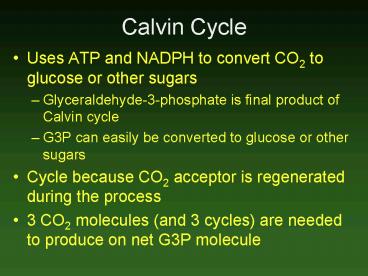Calvin Cycle - PowerPoint PPT Presentation
1 / 11
Title: Calvin Cycle
1
Calvin Cycle
- Uses ATP and NADPH to convert CO2 to glucose or
other sugars - Glyceraldehyde-3-phosphate is final product of
Calvin cycle - G3P can easily be converted to glucose or other
sugars - Cycle because CO2 acceptor is regenerated during
the process - 3 CO2 molecules (and 3 cycles) are needed to
produce on net G3P molecule
2
Calvin cycle
3
Calvin cycle-Carbon fixation
- Carbon from CO2 is added to organic acceptor and
can then be used for synthesis - Ribulose biphosphate (RuBP) is the acceptor
- 5 carbon sugar
- Rubisco (Ribulose biphosphate carboxylase) is the
enzyme that adds the new carbon to RuBP - Most common enzyme on earth
- Results in a 6 carbon molecule that immediately
degrades into two three carbon molecules-3
phosphoglycerate s - has carboxyl group
4
Calvin Cycle-Reduction
- ATP is used to phosphorylate 3-Phosphoglycerate
- New molecule is 1,3-Bisphosphoglycerate
- Activated intermediate
- Electrons from NADPH are used to reduce
1,3-Bisphosphoglycerate - Results in a carbonyl group
- Sugars have carbonyl group
- G3P is produced and it is a 3 carbon sugar
- For every 6 G3P molecules produced-5 are recycled
and one can be used for anabolic rxns
5
Calvin Cycle-Regeneration
- Uses 5 molecules of G3P to produce 3 molecules of
RuBP - Requires ATP to perform this task
- This is why more ATP is needed than NADPH
- Without regeneration of G3P, this would not be a
cyclical reaction - RuBP is ready to act as Carbon acceptor for
fixation stage
6
Where does CO2 come from
- Plants get CO2 from air via stomata
- Have guard cells that open and close stomata
- Also guard against loss of water vapor
7
Photorespiration
- Happens in many plants during hot daytime
conditions-soybeanss - Guard cells close stomata to prevent water loss
- Unable to take up new CO2 molecules
- OxygenCO2 ration shifts
- Rubisco uses O2 instead of CO2
- Eventually yields CO2 for Calvin cycle but so
much effort was expended it is a net loss for
plant
8
C4 Plants
- Way to avoid photorespiration
- Takes place in grasses like corn
- Two types of tissue for photosynthesis
- First acts like antechamber-Mesophyll cell
- PEP carboxylase has higher affinity for CO2 than
Rubisco - Adds Carbon from CO2 onto PEP to form
Oxaloacetate - Eventually CO2 is released into adjacent Bundle
Sheath cell where Calvin takes place - Maintains high CO2 to O2 ratio in BSC
- Rubisco can still use CO2
9
C4 Plants
10
CAM Plants
- Pineapples, cacti and other succulents
- Similar to C4
- Way to get around photorespiration
- Stomata open during night to take in CO2
- Carbon is stored in an organic acid molecule
- During daylight (when light cylce produces ATP
and NADPH) organic acids degrade releasing CO2
into the Calvin Cycle
11
Overview































